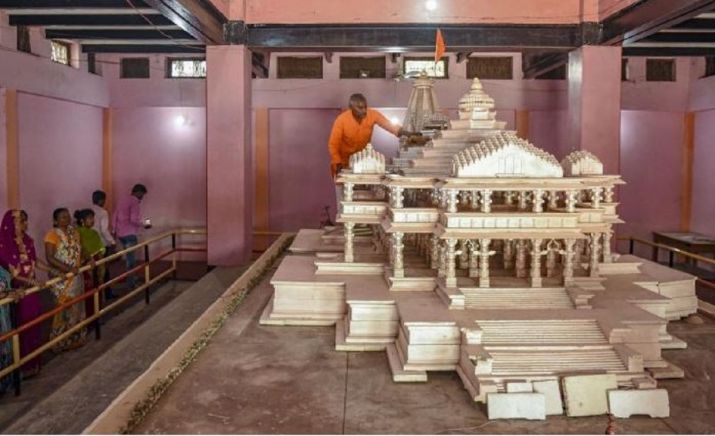
TN right wing 'packs' sand, stone for Ayodhya to rekindle Ram temple spirit

While the BJP is gearing up for the foundation laying ceremony of Ram temple in Ayodhya, their right wing followers in Tamil Nadu have begun to send their support and obeisance, in the form of sand and bricks.
On July 31, the state unit of Vishwa Hindu Parishad (VHP) and Bajrang Dal carried out special poojas in Srirangam Ranganathan temple. This was followed by a ceremony where sand from Cauvery and Kollidam river banks were collected, bundled with silk dhotis, local temple prasadam and sent to Ayodhya in a parcel.
Similarly the RSS and BJP units in Salem district have sent a silver brick weighing 17.4 kg. to Ayodhya. Besides, ‘theertham’ (sacred water) from temples in Kumbakonam and Mahamaham tank too were sent.
A brick made of Gold and another Brick made of silver being sent to Ayodhya from Salem pic.twitter.com/GgIjN9i7Nd
— Mahesh ?? (@Mahesh10816) July 31, 2020
“This is not the first time we have send such bricks. In 1989, too we had shipped 5,000 bricks made in Villupuram. While kneading the clay the brick kiln workers sung bhajans. Even members of muslim community supported us by donating silver bricks”, says S. Vedantham, one of the earliest leaders of the VHP who has been active in the state since 1980s.
It is important to remember Ashok Singhal, the man behind Ram Janmabhoomi agitation, he added. The secretary general of VHP who led the agitation died in 2015 after a bout of illness.
Vedanthan said, “we have asked the people of Tamil Nadu to light a lamp and to chant ‘Ram mantra’, on the day when the temple’s foundations are laid.
VHP has been active in Tamil Nadu since 1981. The state unit even participated in the ‘Ram shilanyas programme’ and consecrated bricks were collected from villages in various parts of the state and sent to Ayodhya.
Similarly when the Supreme Court gave is verdict in favour of Ram Temple in Ayodhya in 2019, a set of 12 bricks were sent to Ayodhya from Tamil Nadu. The bricks sent from Rameswaram by Ram Sena are kept in Karsevapuram in Ayodhya. In February this year Gold bricks were sent to Adyodhya by Bharatha Santana Dharma Seva Trust in Coimbatore.
Madana Gopal, founder, Ram Sena, headquartered in Thanjavur district said it is pleasure to know that the bricks we had sent will be used in the foundation estimated to be 60 feet deep.
“We planned to collect 1,100 bricks on the Rama Navami day on April 2. But due to lockdown this did not materialise, Gopal Said. The bricks were donated by families in Tanjavur and were returned and are now being worshipped at their homes, he said. Once the lockdown is lifted, we will collect the bricks and despatch them to Ayodhya”, he said.
The Tamil version of Valmiki Ramayana is called ‘Kamba Ramayana’, and is revered for its beautiful language.
It is believed that Ramanathasamy temple in Rameswaram was built by Rama. According to the epic Lord Ram built a bridge to Sri Lanka from Rameshwaram in order to reach Sita.
Similarly Ayothiapattinam in Salem district has a Ram temple where his ‘Pattabhishekam’ or coronation ceremony as King of Ayodhya is depicted.
At a place in Point Calimere in Nagapattinam district, ‘Ramar Padam’ or Rama’s footprints are worshipped by the locals. It is believed that Rama came there to get a view of Ravana’s palace that lay across the sea. Since Rama could only observe the backyard of the palace he went to Rameswaram looking for a vantage point.
For Tamils from other parts of the state these spots offer a sort of temple tourism. In Tamil Nadu it is believed that Lord Murugan has a larger following and as far as Vaishnavite traditions go they revere Vishnu and Perumal.
Vedantham rejects these claims. He says,”in Maduranthakam, in Chengalpattu district there is a temple called ‘Eri Kaatha Ramar’ where Lord is supposed to have saved a Lake. Similarly in Kumbakonam, one can see many Rama temples. Besides Rama, there are also Hanuman temples. Though devotees throng all these places a false impression is being created that Rama has no following in the state,” he said.
Interestingly the roots of Ram Janmabhoomi agitation lay in mass conversion that happened in the state in the 1980s.
In 1981, about 150 Hindu families of Meenakshipuram village in Tirunelveli district converted to Islam. As members of Scheduled Castes community they agreed for proselytisation to save themselves from violence and discrimination at the hands of upper caste Hindus.
The news of mass conversion had sent shock waves across the country. The incident sparked a debate over the freedom of religion in India and forced the government to bring anti conversion law. Indira Gandhi, then prime minister ordered an investigation to probe whether foreign money was used for conversion. Then Jana Sangh leader Atal Behari Vajpayee too visited Meenakshipuram to take stock of the situation.
Due to Covid-19, the party has not organised any major program to celebrate the foundation stone laying ceremony, said B Suresh Babu, a member of BJP’s Salem unit.

